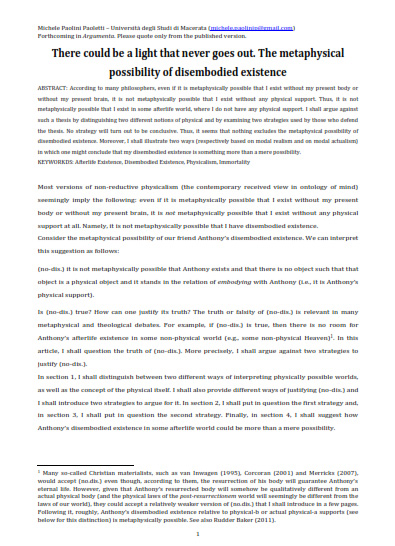There could be a light that never goes out. The metaphysical possibility of disembodied existence

Summary: In 14 pages, the author describes some of modern philosophy’s strongest arguments against non-physical (disembodied) human existence and puts forth astonishingly powerful arguments against their validity. He does so by defining two different notions of physical reality and using them to finely examine the two main strategies put forth by the proponents of the “no-disembodiment” theory, which state that it is not possible for a human to exist without any physical support. He concludes by asserting, by ironic understatement, that disembodied existence (in some “afterlife world”) is probably more than a mere possibility.
Paolini’s impeccable logic is showcased throughout. He takes us to the boundaries of what we would call “conventional wisdom,” and then challenges us to go beyond that. Every question, every answer, broadens the picture he is painting with his pen. For example, many, if not most, people would say that “Anthony” is identical with his physical body, and that consequently, when his body dies, Anthony is extinguished. Paolini follows this up promptly by asking, why is it not more accurate or reasonable to identify Anthony with his (non-physical) collection of memories instead? And since this not outright deniable, doesn’t that mean that actually neither of them are identical with the true essence of Anthony?
These are some terms he uses that caused me some trouble, and necessitated extra readings of this paper, so I’ll briefly outline them here in the hopes that it might help the reader. First, he describes 3 types of “possible worlds”:
- Physically-1 possible worlds - those worlds that share the same (fundamental) physical laws of the actual world in which we currently live
- Physically-2 possible worlds - those worlds that are governed by (fundamental) physical laws. Physically-1 possible worlds are naturally a subset of physically-2 possible worlds
- Metaphysically possible worlds -those possible worlds in which no (openly or covertly) contradictory proposition is true.
These descriptions themselves further illustrate how Paolini starts with what we know and then proceeds to broaden our perspective step by step. Each one of these categories of possible worlds gets larger, with more possibilities as we go down the list.
Second, he describes two different classes of physical objects:
- Physical-b - an object is a physical-b object if and only if it has some paradigmatic features(s) F traditionally attributed to all and only material objects in the “actual world” (e.g., it has spatio-temporal or a temporal location, it is impenetrable, etc)
- Physical-a - an object is a physical-a object if and only if it is part of the ontology of the fundamental physical theory of that world or it is completely constituted by objects that are part of the ontology of the fundamental physical theory of that world.
Again, the set of all possible physical-b objects is a subset of all possible physical-a objects. To bring all of these terms and definitions together for you in two of Paolini’s sentences, allow me to quote from page 10: “[it is possible that] Anthony’s [is] identity-dependent on some actual physical-a object c that could also live in some [physical-2 possible] worlds where fundamental physical laws are radically different [than those of our actual world]. In that world, the object c might turn out to become a somehow immortal composite object, given certain relevant differences in the [fundamental physical] laws (e.g., given the absence of entropy increase).”
While he doesn’t outright suggest that the Subtle Realm exists, he has allowed for the possibility of its existence by merely stating that it is possible that there are worlds that exists with different laws of physics than our own. A simple premise that ought to be hard to reject. He continues, “Perhaps there is a metaphysical possible world in which nothing has F (see definition of physical-b above) and in which Anthony exists: how can we exclude such a possibility -and why should we exclude it?” There are so many more of these interesting “possibilities” that this work serves up to the mind open enough and persistent enough to receive them. Why do I say persistent? Because this work is quite challenging to read and understand; however, it is equally as rewarding.
In closing, I feel strongly inclined to state that the only other time any text challenged me to think this deeply (and in REAL terms) about the afterlife was when I read Plato’s Phaedo many years ago. And just as back then, I thoroughly enjoyed the expansion of my (pre)conceived notions.
Copyright © 2024, SubtleRealm
